Mahesh G R, Technical Manager,
Trouw Nutrition India
Heat stress is a major issue for Indian Poultry producers in India, a tropical country, where temperature can be as high as 45-500 C. Modern poultry birds are more susceptible to heat stress due to their greater metabolic activities leading to greater body heat in combination with less heat dissipation capacity due to lack of sweat glands. Heat stress has been classified into acute and chronic based on the duration of exposure of heat. High humidity worsens the effect of high temperature. So, temperature and humidity index are the ideal indicator to measure heat stress as depicted in Fig. 1.
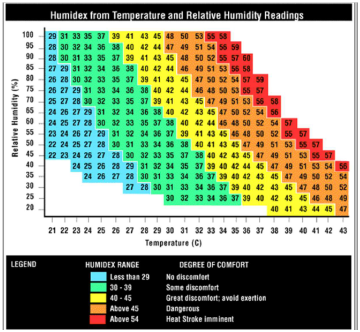
Heat stress index (temperature in Fahrenheit + relative humidity) of 160 or more indicates that the bird is under heat stress.
During periods of heat stress most of the birds consume less feed and more water and most of the energy is diverted towards the maintenance of body temperature which results in oxidative stress induced immunosuppression, predisposing birds to various infectious diseases and high mortality rates. Heat stress has drastic impact on body weight, egg production, egg weight, shell quality etc. (Barret et al., 2019). There are various strategies to minimize heat stress in poultry like, changing physical environmental conditions, genetic modifications, and nutritional modulations. Of these, nutritional strategy is more viable during heat stress as it is based on diet balancing to cover the needs of stressed birds for nutrients at required concentrations. However, recently new techniques are evolving to produce heat resistant chicks either through selective breeding of high-performance heat resistant birds or In-Ovo feeding (Elnesr et al., 2019) practices, which are still nascent and under trial stage.
1. Heat stress and its effects
The most common symptoms exhibited by birds are distended wings, crouched position on the floor, slowness, lethargy, wet feces, increase in water consumption, decrease in feed consumption, panting, deviation of blood from internal organs to the skin, and finally Increase in mortality (fig 1).
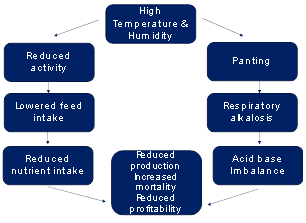
It is a proven fact that feed intake reduces by 1% for each degree rise in temperature up to
320 C. Birds rely on conduction, convection, radiation and panting to reduce heat stress impact. Heat stress has a negative impact on gut health by damaging enterocytes and tight junctions (Fig. 2), which predisposes birds to other systemic infections like salmonella, clostridium, and E. coli due to compromised immunity (Zhang et al., 2017). Loss of tight junction integrity also leads to “leaky gut” conditions and wet litter in poultry.
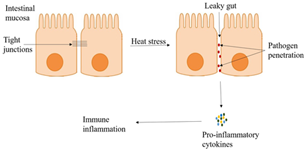
Birds increase the corticosteroid secretion in response to heat stress. During panting in heat stress situations (Fig. 3), there is an excess loss of blood CO2 levels, which leads to the increase in the blood pH, producing metabolic alkalosis. To restore the depleted levels of CO2 in blood, body mobilizes calcium carbonate (Ca2CO3) from the bones to the blood and kidneys excrete bicarbonate (HCO3–) to fight metabolic alkalosis. This compromises the ability of the hen to produce enough calcium carbonate to form the eggshell.
During these times, it is key to maintain enough calcium reserves in the bones through optimal calcium intake and further absorption in the intestine. Because calcium deficiency leads to increase in number of broken eggs, cage layer fatigue and femoral head fractures.
Hence, to combat the ill-effects of heat stress on birds’, poultry producers should resort to an integrated approach combining farm, health, and nutritional management measures.
2. Strategies to reduce heat stress
2.1. Farm and health management
Farm management comprises of management outside and inside the shed, water and feeding management. The house design as per standard dimensions with sufficient overhang and tree cover (Fig. 4) will reduce temperature to a great extent.

Insulation of roofs with thatches and/or heat reflective painting combined with increased ventilation through fans/foggers/sprinklers/evaporative cooling pads, will help to withstand hot weather conditions along with reduced stocking density. Modification of housing, ventilation, and cooling systems needs high initial investments and recurring costs and needs to be judiciously adjusted.
The water consumption of birds increases by 2.5-3.5 times of feed intake, during summer and they prefer consuming cool water. Hence, measures need to be taken to provide cool water, through insulation of water tanks, pipelines, use of good quality ice etc. In terms of water management, increasing the number of drinkers, pipeline flushing, addition of water supplements like water acidifiers, electrolytes, vitamin C, B complex vitamins, vitamin E, aspirin, etc., will help. To compensate for reduced feed intake, birds need to be fed in cooler times of the day, and practices like midnight feeding, increasing feeder numbers, adequate feed bag storage etc. needs to be adopted.
Biosecurity and vaccination protocols need to be followed strictly for maintaining immunity.
2.2 Nutritional interventions
Nutrient density:
It is important that the diets are balanced with important nutrients such as amino acids, calcium, sodium, phosphorus, or vitamins, especially the water-soluble ones. Include highly digestible ingredients in feed, to provide all the necessary nutrients for better absorption, despite the reduction in the feed consumption.
- Feed should be made denser with major nutrients, vitamins, and minerals to compensate for reduced intake
- Protein level in feed should be reduced aptly with concomitant increase in digestible amino acid levels
- Proteins from vegetable source have lower heat increment and are rich in Arginine, and the absorption of latter is compromised in heat stress conditions
- Fats should be increased by 2 to 3% at the cost of carbohydrates without changing Metabolizable Energy (ME), due to the less heat increment of fats
- Calcium levels need to be increased without disturbing the Ca:P ratios
- Micro-nutrients like trace minerals and vitamins need to be increased by 1.25% to compensate for lower intake
Vitamins:
Heat stress reduces the synthesis and increased utilization of Vitamin C, making its supplementation (@150-250 g per ton feed) essential during summer. Sahin & Kucuk, 2003 reported that supplementation of vitamin A, C and E in hot climate helped in enhancing the egg production, fertility along with a reduction in egg breakage and mortality. Vitamin E has free radicals scavenging activity that attacks the free radicals and acts as the first line of defense against lipid peroxidation. Furthermore, it helps in improving fatty acid composition, feed intake, feed efficiency, egg production, egg quality, and oxidative stability of thigh muscle in broilers and quail under heat stress.
Trace Minerals:
Better forms of trace minerals play a critical role in dictating their bioavailability and thereby their utilization in vital metabolic functions. Trace minerals like zinc, manganese and copper have profound effects on eggshell quality, due to their role as co-factors in enzymes involved in eggshell and membrane formation. Hydroxy trace minerals from Trouw Nutrition, Intellibond, is an innovation in trace mineral history and has proven to improve egg production and reduce cracked eggs, as shown in Fig. 5.
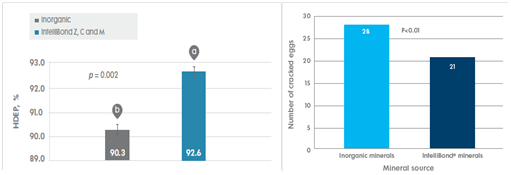
Supplementation of IntelliOpt, an optimal combination of hydroxy (Intellibond) and chelated (Optimin) trace mineral technology, at appropriate inclusion levels, has proved to enhance poultry performance in heat stress conditions.
A combination of vitamins and minerals has a synergistic effect in reducing the effect of heat stress on chickens. Increased body weight, improved feed conversion, and carcass quality were observed in heat stressed birds when supplemented with a combination of vitamin E with Zn in diets (Sahin et al., 2006). While a combination of Zn and vitamin C supplementation resulted in the reduction of blood glucose and cholesterol levels under heat stress (sachin et al., 2009; Yanchev et al., 2007).
Electrolytes:
Electrolytes help in regulating the acid base balance, osmotic pressure of cells and neuromuscular functions. There is increased excretion of electrolytes during heat stress, and addition of appropriate electrolyte salts supports in balancing this loss. Sodium bi carbonate has positive impact on water intake and reducing systemic acidosis.
Osmolytes:
There is excessive loss of body water in heat stress. Supplementation of osmolytes supports in maintaining the body water balance improving the nutrient influx into cells. Betaine, an osmolyte and methyl donor acts as an anti-heat stress agent by promoting favorable gut microbiota, protecting internal organs, and increasing fatty acids catabolism in chickens leading to improved broiler performance (Fig. 6). That said, the form of betaine been supplemented plays a pivotal role, in its aforesaid mechanisms of action, with the betaine from natural source been a better and reliable form than synthetic ones.
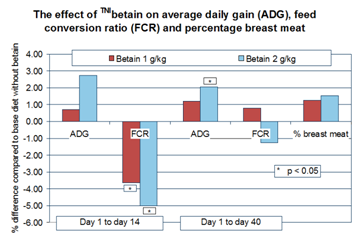
Gut Health promoting concepts:
Inclusion of select combination of organic acids (like Selacid GG MP) helps in achieving eubiotic conditions in gut, improving the tight junction integrity, thereby reducing the susceptibility of birds to infections, consequently improving the birds’ growth and productive performance. Also, probiotic and prebiotic supplements used in heat-stressed birds to reduce the detrimental effects of heat stress by promoting the growth of beneficial bacteria (Sohail et al., 2011 and Deng et al., 2012). Immunosuppressed birds in heat stress can be prone to multiple mycotoxin challenge, that could challenge the gut health status of birds. Addition of apt broad spectrum mycotoxin binders along with immune boosting concepts, as in Toxo XL, can help in improving gut health in heat stressed birds.
In-Ovo Feeding:
In-Ovo feeding is a novel solution adopted in eggs right after laying and has been used for supplementing various nutrients such as carbohydrates and trace minerals to the developing embryo (Goel et al., 2016). However, it’s still at budding stage so, commercial application needs to be validated.
Conclusion
Heat stress contributes to a series of physiological changes, including systemic immune dysregulation, endocrine disorders, respiratory alkalosis, and electrolyte imbalance, which affects the health and performance of the chickens leading to lowered performance and profitability. Heat stress leads to challenged gut health conditions and oxidative stress through generation of Reactive oxygen species (ROS). A holistic approach comprising of strategies to optimize farm, feed, and health, must be adopted to handle challenges arising out of heat stress. Supplementation of various dietary additives in right concentrations will help in reducing the adverse effects of heat stress.
For further information, kindly write to us at customercareindia@trouwnutrition.com or visit our website: www.trouwnutrition.in